Regulatory network mediated by RBP-J/NFATc1-miR182 controls inflammatory bone resorption
- PMID: 31908034
- PMCID: PMC7018544
- DOI: 10.1096/fj.201902227R
Regulatory network mediated by RBP-J/NFATc1-miR182 controls inflammatory bone resorption
Abstract
Bone resorption is a severe consequence of inflammatory diseases associated with osteolysis, such as rheumatoid arthritis (RA), often leading to disability in patients. In physiological conditions, the differentiation of bone-resorbing osteoclasts is delicately regulated by the balance between osteoclastogenic and anti-osteoclastogenic mechanisms. Inflammation has complex impact on osteoclastogenesis and bone destruction, and the underlying mechanisms of which, especially feedback inhibition, are underexplored. Here, we identify a novel regulatory network mediated by RBP-J/NFATc1-miR182 in TNF-induced osteoclastogenesis and inflammatory bone resorption. This network includes negative regulator RBP-J and positive regulators, NFATc1 and miR182, of osteoclast differentiation. In this network, miR182 is a direct target of both RBP-J and NFATc1. RBP-J represses, while NFATc1 activates miR182 expression through binding to specific open chromatin regions in the miR182 promoter. Inhibition of miR182 by RBP-J servers as a critical mechanism that limits TNF-induced osteoclast differentiation and inflammatory bone resorption. Inflammation, such as that which occurs in RA, shifts the expression levels of the components in this network mediated by RBP-J/NFATc1-miR182-FoxO3/PKR (previously identified miR182 targets) towards more osteoclastogenic, rather than healthy conditions. Treatment with TNF inhibitors in RA patients reverses the expression changes of the network components and osteoclastogenic potential. Thus, this network controls the balance between activating and repressive signals that determine the extent of osteoclastogenesis. These findings collectively highlight the biological significance and translational implication of this newly identified intrinsic regulatory network in inflammatory osteoclastogenesis and osteolysis.
Keywords: inflammatory bone resorption; osteoclast; osteoimmunology; rheumatoid arthritis.
© 2019 Federation of American Societies for Experimental Biology.
Conflict of interest statement
Figures
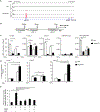

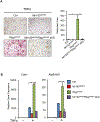

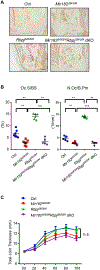
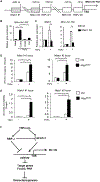
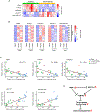
Similar articles
-
Intrinsic Restriction of TNF-Mediated Inflammatory Osteoclastogenesis and Bone Resorption.Front Endocrinol (Lausanne). 2020 Oct 8;11:583561. doi: 10.3389/fendo.2020.583561. eCollection 2020. Front Endocrinol (Lausanne). 2020. PMID: 33133025 Free PMC article. Review.
-
RBP-J-Regulated miR-182 Promotes TNF-α-Induced Osteoclastogenesis.J Immunol. 2016 Jun 15;196(12):4977-86. doi: 10.4049/jimmunol.1502044. Epub 2016 May 9. J Immunol. 2016. PMID: 27183593 Free PMC article.
-
TNF-induced osteoclastogenesis and inflammatory bone resorption are inhibited by transcription factor RBP-J.J Exp Med. 2012 Feb 13;209(2):319-34. doi: 10.1084/jem.20111566. Epub 2012 Jan 16. J Exp Med. 2012. PMID: 22249448 Free PMC article.
-
RBP-J imposes a requirement for ITAM-mediated costimulation of osteoclastogenesis.J Clin Invest. 2014 Nov;124(11):5057-73. doi: 10.1172/JCI71882. Epub 2014 Oct 20. J Clin Invest. 2014. PMID: 25329696 Free PMC article.
-
Recent advances of NFATc1 in rheumatoid arthritis-related bone destruction: mechanisms and potential therapeutic targets.Mol Med. 2024 Feb 3;30(1):20. doi: 10.1186/s10020-024-00788-w. Mol Med. 2024. PMID: 38310228 Free PMC article. Review.
Cited by
-
Intrinsic Restriction of TNF-Mediated Inflammatory Osteoclastogenesis and Bone Resorption.Front Endocrinol (Lausanne). 2020 Oct 8;11:583561. doi: 10.3389/fendo.2020.583561. eCollection 2020. Front Endocrinol (Lausanne). 2020. PMID: 33133025 Free PMC article. Review.
-
Suppressing ERp57 diminishes osteoclast activity and ameliorates ovariectomy-induced bone loss via the intervention in calcium oscillation and the calmodulin/calcineurin/Nfatc1 pathway.Heliyon. 2024 Jul 27;10(15):e35374. doi: 10.1016/j.heliyon.2024.e35374. eCollection 2024 Aug 15. Heliyon. 2024. PMID: 39170388 Free PMC article.
-
Targeted apoptosis of macrophages and osteoclasts in arthritic joints is effective against advanced inflammatory arthritis.Nat Commun. 2021 Apr 12;12(1):2174. doi: 10.1038/s41467-021-22454-z. Nat Commun. 2021. PMID: 33846342 Free PMC article.
-
Another Notch in the Belt of Rheumatoid Arthritis.Arthritis Rheumatol. 2024 Oct;76(10):1475-1487. doi: 10.1002/art.42937. Epub 2024 Aug 9. Arthritis Rheumatol. 2024. PMID: 38961731 Review.
-
Role and Regulation of Transcription Factors in Osteoclastogenesis.Int J Mol Sci. 2023 Nov 10;24(22):16175. doi: 10.3390/ijms242216175. Int J Mol Sci. 2023. PMID: 38003376 Free PMC article. Review.
References
-
- Novack DV, and Teitelbaum SL (2008) The osteoclast: friend or foe? Annu Rev Pathol 3, 457–484 - PubMed
-
- Schett G, and Teitelbaum SL (2009) Osteoclasts and arthritis. Journal of bone and mineral research : the official journal of the American Society for Bone and Mineral Research 24, 1142–1146 - PubMed
-
- Boyce BF, Yao Z, Zhang Q, Guo R, Lu Y, Schwarz EM, and Xing L (2007) New roles for osteoclasts in bone. Ann N Y Acad Sci 1116, 245–254 - PubMed
-
- Sato K, and Takayanagi H (2006) Osteoclasts, rheumatoid arthritis, and osteoimmunology. Current opinion in rheumatology 18, 419–426 - PubMed
Publication types
MeSH terms
Substances
Grants and funding
LinkOut - more resources
Full Text Sources
Molecular Biology Databases
Research Materials
Miscellaneous

